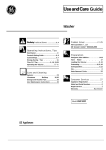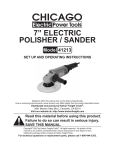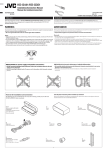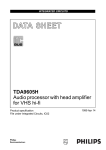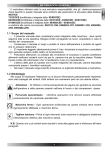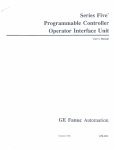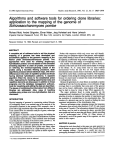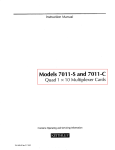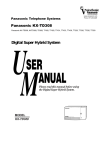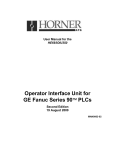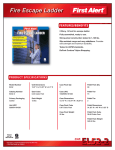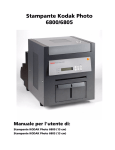Download Series Five Programmable Controller User`s Manual, GFK
Transcript
Chapter 51 3 Maintenance m GFK-0122 Introduction This chapter presents Logic Controller. The failure should occur, minimum downtime. hardware or software assemblies (modules), a basic guide to troubleshooting procedures for the Series Five Programmable Series Five PLC is designed to provide many years of trouble free operation. If a it can usually be quickly isolated and the defective assembly replaced with It is important to quickly identify the source of the problem, and whether it is related. The maintenance concept for the Series Five PLC is to replace failed rather than individual components. Troubleshooting Aids The CPU has many internal bits and diagnostic registers which can be used in the user program or external CCM compatible computer to implement a custom diagnostic package. Many of these internal bits and registers are used by Logicmaster 5 to report errors. Most typical problems are isolated through interpretation of the LEDs on individual modules or through error codes or messages on the programming device’s screen These troubleshooting aids help diagnose not only the Series Five PLC, but also the total control system. The main diagnostic tool is the programming device, which can be a Workmaster II portable computer, a Workmaster, or Cimstar I industrial computer, or an IBM PC, XT, AT, PS/2 or compatible personal computer with Logicmaster 5 software. Many hardware related faults can be attributed to incorrect switch settings, loose cables or screw connections - all major faults can be corrected by replacing modules. There are usually no special tools required other than a screwdriver and a voltmeter. Series Five Diagnostic Aids The diagnostic features of the Series Five PLC provide the user with a powerful, easy to use troubleshooting tool. These diagnostic features not only tell you that an error has occurred, they also lead you to the location of the problem. These diagnostic features are: status indicators on the CPU and all other modules, special purpose internal coils that turn on to reflect error conditions, reserved registers that indicate an error code number or other tiormative information, the CPU ERROR FLAGS display in the Scratch Pad screen in Logicmaster 5, and the error display in the OIU. Logicmaster 5 provides the tools for displaying and interpreting error messages and leading you to the cause of the problem. When a failure occurs, a bit or bits will be set in the CPU ERROR FLAGS line at the bottom of the Scratch Pad display, and an error message will be displayed. In most cases, the cause of the problem is indicated. If additional information about the problem is needed, by accessing a HELP screen, you are directed to an explanation of the bit or bits that are set, i.e., the nature of the error. You can then display the reference table for the special contacts (Il-000 to 11-5 12) to see which of the contacts has been set to a logic 1 or access the register display and look at registers 4078,4079, and 4080. These registers will display an error code number. Then refer to table 5.2 for error code definition and the action to take to clear the problem. The flow chart on the following page shows the recommended Five PLC. troubleshooting procedure for the Series 52m Maintenance GFK-0122 a42408 ) Turn power on to power supply. Connect power supply source voltage wiring. Ensure that jumper is configured correctly for 115 or 230 VAC - for AC supplies. Replace power supply. Read error message in LM5 Scratch Pad. See Table 5.1 below for messages and action to clear error. Look at Registers 4078,4079, and 4080 in Hexadecimal display mode. Error codes are read from these registers. If contents are non-zero, refer to TaMe 5.4 for error code definition. If not enough information to solve problem refer to tabie 5.2 for definition of special bits. mcorrect cause of error by taking corrective action as listed under “ACTION TO CLEAR I ERROR” in Table 5.4. Figure 5-l. Recommended Troubleshooting Sequence Flow Chart 53m Maintenance GFK-0122 Table 5-l. Scratch Pad Error Messages and Corrective Action ~~ Comxtive Scratch Pad Error Message Compilation Error CPU Battery Low Duplicate I/O Address Error I/O Address Range Error I/O Bus Error I/O Cotig Changed I/O Enor I/O Module Removed I/O Parity Error Memory Battery low NO CPU BATTERY NO Battery in memory cartridge No Memory Cartridge Error Program Error Program Parity Error Watchdog Timer Timed Out Action Store program to CPU again Replace CPU battery within one week Reassign addresses and do a STORE TO CPU. Correct user logic and store program again. Cycle from STOP to RUN, or reset CPU with reset switch, or Recycle power, or replace base unit or device on bus. Key-in NEW CONFIG or OLD CONFIG command from LM5 or edit I/O map and do a STORE TO CPU, or return to previous I/O configuration. See Table 5.2 in this chapter for further information. With power off, replace module. Or edit I/O map and STORE TO CPU Cycle f!rom STOP to RUN, or reset CPU with reset switch, or cycle power. Replace base unit, or device on I/O bus. Replace memory cartridge battery within one week. Connect or instaIl back-up battery in CPU. Install battery in memory cartridge. With power off - install memory cartridge. Check user program, correct error and store program again Store program again. Cycle power. Check user logic or increase Watchdog Timer preset value. Table 5-2. Special Purpose Contact (Bit) Definition ^ - Reference 11-0033 11-0034 11-0035 11-0036 11-0037 11-0038 11-0039 Error Critical System Error Non-Critical System Error Diagnostic Error Battery Not Normal Memory Error I/O Error Communications Error I/O ConQuration Error 11-0042 11-0043 11-0044 11-0045 11-0065 Watchdog Timeout Internal Program Error Internal Math Error Smart Module Comm. Error I/O Retry Parity Status 11-0066 Non-Critical Rack DdhitiOIk 1= 1= 1= 1= l= l= l= error, CPU goes to STOP mode. error, CPU remains in RUN mode. error detected CPU or memory cartridge battery voltage low. latches if a memory cartridge error occurs. latches if I/O bus error is detected Turned ON by a CPU/CCM error. Next successful communications will turn it off. lo?=error detected, I/O configuration has changed since last power-up. 1 = Watchdog timer has timed out. 1 =Error l=Error 1 =Error 1 = Parity error after specified number of retries 0 = OK, no parity error detected 1 = Non-critical rack 0 = Critical rack (that reported parity error setting 11-0065) 54m Maintenance GFK-0122 CPU Status Indicator Definitions The flow chart for basic troubleshooting procedures indicates that observation of system indicator lights is a good starting point to use for troubleshooting. The following table defines the LED status indicators ’ located on the CPU. . Table 5-3. CPU Status Indicator Definitions LED DESCRIPTION COLOR PWR GREEN ON - Power is applied to the CPU and the +5 Vdc operating voltage is within specified tolerance. OFF - AC or dc input power source is missing or the +5 Vdc operating voltage is not withk specified tolerance. RUN GREEN ON CPUisintheRUNmode. OFF - CPU operation is halted, CPU RED ON - A malfunction exists in the CPU or the watchdog timer has timed out. OFF - CPU is operating normally and the watchdog timer has not timed out. DIAG RED ON - CPU has detected an internal fault that causes the CPU to halt its scanning Operation. OFF - Operation normal, no faults detect& BA’IT AMBER ON - A memory backup battery voltage is low or has failed. Can be eith& in the CPU or memory cartridge battery. OFF - Both backup batteries operating normally. MEM AMBER ON - A program memory error has been detected OFF - All memory operating without error. I/O AMBER ON - An I/O error has been detected. OFF - No I/O errors have been detected. COMM AMBER ON - A communications error has been detected OFF - Communications operating without error. For detailed exror definitions, refer to the Logicmaster 5 Scratch Pad Display and Register tables (R4078,4079, 4080). Maintenance 55 m GFK-0122 Error Definition and Action Required The LEDs on the CPU are a good troubleshooting aid. When combined with the capabilities of the programmer with Logicmaster 5 or when using the Series Five Operator Interface Unit, you can quickly troubleshoot the majority of system errors that may occur. The following table lists the errors that may be detected by the CPU. Two tables are found in this section - the first lists the error codes, definitions and corrective actions when using Logicmaster 5 software, and the second table lists error codes and messages, cause of error, and corrective actions when using the Operator Interface Unit. The information in the tables is as follows: ERROR CODE/MESSAGE: CAUSE OF ERROR: ACTION TO CLEAR ERROR: Error code number and message (message with OIU) Action or problem that caused the error. Action required to clear the error. Table 514. Error Code Definitions - Logicmaster 5 . Error Code Action Cause of Error E003 Scan time exceeds Preset time of Watchdog timer EOO4 E041 E042 E043 CPU memory parity error detected Voltage of CPU back-up battery too low. No back-up battery in CPU. Voltage of back-up battery installed in memory cartridge too low. * E044 El01 No battery or dead battery in memory cartridge. No memory cartridge in CPU. El02 Memory cartridge contains only CPU parameters. El03 Memory cartridge contains only registers. El50 El51 El52 Register reference is greater than maximum register size. Memory parity error in user logic. \\ Rung too complex to execute. E201 E202 E222 Terminal block removed from I/O module. I/O con@uration change since last power-up, or I/O module removed Tom slot. Blown fuse or no fuse in an output module. FU indicator on output module will also be 0111, Voltage of external 24 V dc power to output module too low. No power applied to Series Three PLC’s I/O base unit connected through a Series Three PLC I/O Interface module. A problem exists in the Series Three PLC’s I/O system. E250 Error on I/O bus or device connected to I/O bus. E203 E204 E221 to Clear Error Check user logic or increase watchdog timer preset Cycle power. Store program again Replace CPU battery within one week. Install back-up battery in CPU. Replace battery in memory cartridge within one week Contents of memory cartridge must be copied before you change the batteryordatawillbelost. Install battery in memory cartridge. With power off, install memory cartridge in CPU. With power off, insert user program MC in the CPU. With power off, insert user program MC in the CPU. Change register reference. Store program again Change user logic program to have fewer stack levels. With power off, install terminal block. With power off, install I/O module in correct slot With power off, remove output module and install new fuse, or replace module. Adjust voltage of external power supply. Apply power to the Series Three PLC’s I/O base unit. Troubleshoot the Series Three PLC’s I/O system and replace defective module(s). Recycle power, or push CPU reset pushbutton, or replace base unit or device. . 56I Maintenance Table 5-4. Error Code Definitions - Logicmaster 5 - Continued Error Code Cause of Error E251 I/O bus parity error, noise. E252 Current I/O configuration is different than the one stored in the memory cartridge. E261 E262 E350 E351 E352 E353 E354 E4xx I/O address duplicated when assigned manually. I/O address in user logic exceeds valid address range. Specified target address is not an intelligent module. Invalid ID specified for intelligent module (target). Syntax error present in command parameters Timeout when communicating with target. No infomation obtained from target device Translated program error. Action to Clear Error Cycle power. Replace base unit, or device on I/O bus. Key-in NEW CONFIG command or OLD CONFIG command from LM5 or edit I/O map and do a STORE TO CPU. Reassign addresses with no duplication. Correct user logic. Specify correct target address. Reassign correct target ID. Use correct syntax@uameters. Check target source and all interconnects. Verify target information Check and reload program. Table 54. Error Code Definitions - Operator Interface Unit Error Message EO03 S/W TIMEOUT E041 CPU BATTERY LOW E042 NO CPU BATI’ERY E043 CPU MC BATTERY LOW EO44 NO MC BATT El01 NO CPU MC Cause of Error Action to Clear Error CPU scan time was greater than software Set longer software watchdog (sub-menu 54) or change ladder logic. watchdog timer. Replace CPU battery, Cat. No. Low voltage on CPU back-up battery. IC655ACC550 Install or reconnect CPU battery. Missing or disconnected CPU battery. Low voltage on CMOS RAM memory Copy program to another memory carbattery tridge and replace cartridge battery. (IC655ACC549). Missing CMOS RAM memory cartridge Install battery in memory cartridge. battery. Attempt to access CPU MC when it is not Insert memory cartridge into CPU. install& El02 MC HOLDS SYS DATA Attempt to run CPU with MC installed Replace with a program memory carthat contains only system parameter tridge. El03 MC HOLDS REG DATA Attempt to run CPU with a memory car- Replace with a program memory cartridge. tridge that contains register data Copy operation to CPU MC in Menu 7 Reconfigure the jumper in memory carfailed because cartridge is write protect- tridge to the write enable position. If problem still exists - replace memory ed. cartridge. El04 WRIIE FAILED El50 REG REF TOO LARGE El51 BAD COMMAND El52 PROG STACK OVERFLOW Register reference larger than maximum Change register reference. register size. Parity check detects error in program Rewrite the invalid code to correct the logic. stored on the CPU memory cartridge. Change logic to have fewer stack levels. Rung too complex to execute 57m Maintenance GFK-0122 Table 5-S. Error Code Definitions - Operator Interface Unit - Continued Error Message E2XX DIAG ERROR MENU 42 Cause of Error Action to Clear Error 4n I/O diagnostic error has been reported to the CPU. Jse sub-menu 41 or visual inspection to determine the type of error, and take corrective action. Error can be one or more of errors E201 to E262. E201 MISSING TERM BLOCK ~~)se or missing terminal block on I/O he sub-menu 41 or visual inspection to find module location. With power off module. tighten terminal block or install new terminal block on module. E202 MISSING I/O MODULE /O module loose or missing since last Jse sub-menu 41 or visual inspection to power cycle. determine module type and location of missing module. With power off - install module and secure to base unit. he sub-menu 41 or visually find module ?use blown on an output module. type and location. With power off replace fuse or module. 3xtemal24 Vdc power supply is too low Sdjust voltage, correct fault or replace or has failed. supply* I/a l/a E203 I/O MDL FUSE BLOWN E204 LOW VOLTAGE EXT PS E208 ILLEGAL MODULE CODE E221 NO SERIES 3 I/O PS E222 S3 I/O ABNORMAL OP E226 PS OVERLOAD E250 I/o CHAIN E251 I/O BUS PARITY E252 NEW I/O CONFIG/ E261 I/O ADDR CONFLICT E262 I/O OUT OF RANGE E311 COMM ERROR 1 E312 COMM ERROR 2 E313 COMM ERROR 3 E316 COMM ERROR 6 ?ower supply failed or power @offon Se- hn on power, repair or replace power supply in Series Tbree base unit. ries Three I/O base unit. Series Three I/O module or modules fhc- ktermine which module is defective and _ replace. tioning abnormally. 2PU has detected that I/O loading in a Jse high capacity power supply or adjust base unit exceeds the power supply ca- I/O module arrangement. pacity. ?aulty link in the I/O chain. Zheck I/O expander cables, Local I/O Interface module. Parity error on I/O bus due to electrical Cycle power, if CPU won’t enter RUN mode, replace base unit or device on noise or other type of interference. bus . Current I/O configuration is different than Use submenu 45 to select the former or the one stored in CPU memory cartridge. the new config, or change I/O config to its previous configuration. Attempt made to force a module to an Use sub-Menu 46 to change one of the address already assigned to another modules address to a avoid duplication. module. &tempt made to force a module address Use sub-menu 46 to re-enter a valid address. to an invalid address. A non-existent operation code was includ- Key-in CLR to retry the communications. ed during a CCM communications session. A non-existent operation code included Key-in CLR to retry the communications. during communications with a program mer. A non-existent address was included dur Key-in CLR to retry the communications. ing communications with a programmer A non-existent mode was included during Key-in CLR to retry the communications. communications with a programmer. 580 Maintenance GFlLO12 Table 5-S. Error Code Definitions - Operator Interface Unit - Continued Error Message Cause of Error Action to Clear Error E320 OIU-CPU TOUT Communications time out between CPU Cycle power. If problem persists - replace and OIU. faulty unit (OIU or CPU). E321 OIU-CPU COMM No reply or NAK from the CPU to an Check link between the OIU and the CPU. OIU ENQ. Cycle power. If problem persists - replace the CPU. E350 MODULE ADDR A base unit and slot address has been Reassign the intelligent module address specified that does not contain an intelli- either in the user logic program or gent module - when attempting commu- through sub-menu 47 on the OIU. nications between intelligent modules or between OIU to intelligent modules. E351 MODULE ID Invalid communications ID number speci- Reassign the correct intelligent module ID fied for an intelligent module during in user logic program. communications between intelligent modules. E352 BGND SETTING Syntax error occurred during background Key-in CLR and retry communications. communications. E353 BGND TOUT Communications time out during commu- Key-in CLR and retry communications. nications session between two intelligent modules. E360 TIME OUT During communications between a per- Press the CLR key and retry communicasonal computer and OIU, the personal tions. computer did not respond to an enquiry. E361 COMM ERROR Communications problems between CPU Retry communications,‘check cable conand OIU. nections, check OIU mounting to CPU. E4= Mode keyswitch turned to RUN with no Download program from computer to program in the CPU memory cartridge. CPU, or insert memory with program. NO PROGRAM E501 BAD ENTRY Invalid key sequence attempted before Rekey correct sequence of keys. ElNT, PREV, or NEXT keys. E504 BAD REF/VAL Reference number or value entered is out Re-enter correct value. of range. E520 BAD OP-RUN Attempt made to perform an operation which is illegal when the CPU is in the RUN mode. Attempt made to perform an operation which is illegal when the CPU is in the RUN w/OUTPUTS DISABLED mode. Attempt made to perform an operation which is illegal when the CPU is in the STOP mode. CPU mode keyswitch not in the OIU position. E521 BAD OP-RDIS E524 BAD OP-STOP Es25 KEYSWITCH E526 OIU OFFLINE E540 CPU LOCKED E541 WRONG PWORD Change CPU mode to allow the operation. Change CPU mode to allow the operation. Change CPU mode to allow the operation. Turn key to OIU position. Attempt to perform an operation while Use sub-menu 64 to put OIU on-line. OIU is off-line. Attempt to perform a password protected Logon to the locked CPU with sub-menu operation without logging-on to the 81, and repeat operation. locked CPU. Wrong password entered for the memory Re-enter correct password for the memory cartridge in the OIU. cartridge in the OIU. 59w Maintenance GFK-0122 Table 5-S. Error Code Definitions - Operator Interface Unit - Continued Error Message %Ol MEMORY FULL Cause of Error , Attempt to program instruction too large Copy program onto a larger memory car- for available memory. E603 DATA MISSING E610 BAD I/O TYPE Action to Clear Error tridge and continue entering program. While searching for data in registers Press CLR and respetify data value or (sub-menu 33), no data that was speci- register range. fied was found in the specified register range. Attempt made to read/write an intelligent Retry operation - specify correct base I/O module through sub-menu 47; how- unit/slot for the intelligent module. ever, location specified was for a conventional I/O module. E611 BAD COMMS ID Attempt made to communicate with a Set correct CCM ID. CCM station ID that does not exist. E620 OUT OF MEM Copying operation incomplete because of Change to larger memory cartridge, or insufficient memory remaining on mem- restructure program. ory cartridge. (1) Blank check with sub-menu 74 has Clear the memory cartridge using detected data on the OIU memory car- sub-menu 75 or use another memory cartridge. tridge. (2) Attempt to copy to or erase a write Change jumper in memory cartridge to unprotected position. protected RAM or EEPROM cartridge. E621 MC NOT BLANK (3)Attempt to copy to UVEPROM car- Erase contents of UVEPROM cartridge with an ultra violet lamp, or use another tridge that already contains data. UVEPROM cartridge. b E622 NO MC IN OIU Attempt ma& to transfer data to or from a Insert an appropriate meniory cartridge inmemory cartridge in the OIU with no to the OIU. memory cartridge installed in the OIU. E623 SYSTEM MC Attempt made to transfer user logic fkom Remove memory cartridge Tom OIU and OIU memory cartridge to CPU memory insert one that contains user logic. cartridge when OTU memory cartridge contains other than user logic. E624 REGS ONLY Attempt made to transfer user logic from Remove memory cartridge f!rom OIU and OIU memory cartridge to CPU memory insert one that contains user logic, or cartridge when OIU memory cartridge select register option from sub-menu 72. contains register daW E625 PROG ONLY Attempt made to transfer registers from Remove memory cartridge Tom OIU and the OIU memory cartridge to the CPU insert one that contains register data, or select program option from sub-menu memory cartridge when the OIU meme 72 . ry cartridge contains user logic. E626 EPROM MC Attempt ma& to copy data onto an Install a RAM or EEPROM cartridge in EPROM memory cartridge installed in the CPU, or insert the EPROM memory cartridge in the OIU to copy data. the CPU. E627 BAD WRITE RAM or EEPROM cartridge in OIU is Reconfigure the memory cartridge jumper write protected, or UVEPROM cartridge to the write enable position. in OIU has not been eras& or CPU has detected a mismatch of data while copying data with sub-menu 71 or 72. E640 MISCOMPARE Data mismatch detected while performing Clear the OIU or CPU memory cartridge, as applicable, and retry the copy operaa verification in sub-menu 73 or 79. tion. 540 Maintenance GFlC-0122 Table 5-5. Error Code Definitions - Operator Interface Unit - Continued Error Message Cause of Error Action . to Clear Error E641 VOLUME LEVEL Cassette recorder volume level set too Readjust volume level and repeat operahigh or too low when in sub-menu 77, tion. 78, or 79. E642 CHKSUM ERROR Checksum error when copying between Repeat operation, after clearing the OIU cassette tape and OIU, or external com- memory cartridge, or other medium puter and OIU. where appropriate. E650 MACHINE CODE CPU detected an unknown op code value Press CLR key. If problem persists, during execution of a program instruc- reload program or provide more protection. tion from electrical noise or other interference for CPU. E651 SYSTEM ROM Checksum error exists in OIU ROM. Press CLR key and repeat operation. If problem persists - replace the OIU. E652 SYSTEM RAM Checksum error exists in OIU RAM Press CLR key and repeat operation. problem persists - replace the OIU. E653 MC BATI’ LOW Battery voltage in OIU memory cartridge Replace battery in memory cartridge, or low. use another memory cartridge. If General I/O Troubleshooting Procedures I/O troubleshooting procedures depend upon knowledge of the logic program installed for your application. The following procedures are general in nature, and should be adjusted to fit your specific application. The following steps assume that the CPU is in the RUN mode - operating with outputs enabled. 1. If the Series Five PLC has stopped with some of the outputs energized, locate the signal (timer, coil, input, etc.,) that should cause the next operation to happen. The state of that signal can be monitored by Logicmaster 5. 2 . If the signal is an input, compare the state of the input monitored with the programmer, with the state of the LED for that input on the input module. If they are different, replace the module. Do not install or remove any I/O module when power is applied to the base unit. Failure to adhere to this warning could cause a module to be damaged. Voltages from user devices may be present on a module’s screw terminals, though power to a base unit is turned off. Care must be taken any time that you are handling the module’s terminal board or any wires connected to it. 3 . If an input state and the applicable LED on the input module agree, compare the LED status with the actual input device (limit switch, pushbutton, etc.). If they are different, measure the voltage at the input module terminals. Refer to the Series Five Programmable Controller II0 Specifications Manual, GFK-0123, for specific module information. If the measured voltage indicates a faulty I/O device - replace it, or the field wiring, or its power source. If this does not solve the problem, replace the input module. Maintenance 5-11 GFK-0122 4 . If the signal is a coil wired to a field device, compare its status to the LED on the applicable output module. Lf they are different, check the power source to ensure that an excitation voltage is available. If field power to the device is not present, check the power source and its wiring. If the correct field power source is available, but the status is wrong at the output module - replace the output module. 5. If the signal is a coil, and either there is no output module or the output is the same as the coil state, examine the logic driving the output using the progr amming device, and a hard copy of your Working from right towards left, locate the first contact that is not passing power program. available to it from the conditional logic at its immediate left. Troubleshoot that signal using the procedures in steps 121 and m if the signal is an input, or steps and if the signal is a coil. q q 6 . If the signal is a timer that has stopped at a non-zero value below its preset value, replace the CPU module. 7 . If the signal is the control over a counter, examine the logic that is controlling the reset first - then the count signal. Follow steps a through m. Replacing Components The following procedures PLC system. provide information on replacement of various components * of a Series Five Replacing a Power Supply 1. Turn off AC or DC power, as applicable, to the supply. 2. Disconnect field wiring from the power supply terminal block. a42666 I * 0 RUN RUN RUN C (SIGNAL GROUND) 0 18 C (SlGNAL GROUND) I@ C (SIGNAL GROUND) 0 t0 I0 i G (CHASSIS GROUND) 1@ :‘G (CHASSIS GROUND) AC - HOT 18 I0 AC - NEUTRAL E? 0 0 115 VAC JUMPER CONNECTED Figure 52. AC-HOT 24 VDC - POS AC - NEUTRAL 24 VDC - NEG NO CONNECTION 230 VAC JUMPER NO IC655PWR500 IC655PWR501 G (CHASSIS GROUND) NO CONNECTION 1 IC655PWR514 Power Supply Terminal Block Connections s-12 Maintenance GFK-0122 3 . Remove the power supply by loosening the two captive screw fasteners that are holding the supply in place. 4 . Install the new power supply by placing it over the connector on the backplane and pushing down on the module until it is f’lrmly seated. 5 . Reconnect field wiring to the power supply terminal block, and verify that the jumper for 115 or 230 V ac is properly configured if the supply is an AC supply. 6 . Apply power to the system and check for proper system operation. Replacing a CPU Module 1. Place the CPU mode switch in the STOP position. power supply. Turn off AC or DC power, as applicable, to the 2 . Disconnect any cables that may be attached to the CPU. Remove the memory cartridge installed in the CPU. Write down the DIP switch settings to ensure that the settings on the new CPU are the same. 3 . Remove the CPU from its slot by loosening from its backplane connectors. the two captive screws and pulling the module away 4 . Install the new CPU module, and tighten the two captive screws. 5 . Ensure that the DIP switch settings are correct for your operation and verify that the CPU backup battery is properly installed . 6 Reconnect l 7. any cables, you may have removed, to the CCM port connectors on the CPU. Apply power and verify system operation. Replacing a Memory Cartridge 1. Place the CPU mode switch in the STOP position. power supply. Turn off AC or DC power, as applicable, to the 2 . Open the top hinged door on the front of the CPU to gain access to the memory cartridge. 3 . Remove the memory cartridge by grasping the top of the plastic strip at the point marked “PULL”, then pull it towards you. The cartridge will slide out of its slot. Do not remove or insert a memory cartridge with power on. Handle RAM memory cartridges with care, since excess charges of static electricity could damage the memory devices in the cartridge. 4 . Install the new memory cartridge by orienting the cartridge so that the word “PULL” is towards the top of the CPU, then slide the cartridge carefully into the guides in the slot until it firmly plugs into the connector at the back of the slot. 5 . Turn on AC or DC power to the base unit and verify proper system operation. Maintenance 5-13 GFK0122 Replacing a Memory Cartridge Backup Battery 1. Before replacing a memory cartridge battery, the memory contents memory in the cartridge will be lost when a battery is changed. should be saved, since the 2 . Remove the memory cartridge as described previously. 3 . Remove the phillips head screw that attaches the top cover to the case containing the memory cartridge. a42417 Figure 5-3. Memory Cartridge Battery Location 4 . You do not have to remove the circuit board from the case battery is mounted on the circuit board and can be removed of the battery until it is completely free of the socket. It is or a non-conductive tool for pulling the battery out of the to remove and replace the battery. The by very gently pulling up on the bottom recommended that you use your fingers socket. Be very careful when removing the battery from its mounting holes to ensure that the circuit board is not damaged. Be careful not to short runs or components on the circuit board when using a screwdriver. 5 . Notice that the holes into which the battery is inserted are offset to one side, this ensures that proper battery polarity is observed. Insert the new battery into the mounting holes by placing it over the holes, then gently pushing down on the battery case until it is firmly seated in place. Do not bend the two leads on the battery. 6 . Replace the cover and replace and tighten the screw. Before turning on power, ensure that the CPU mode keyswitch is in the STOP position. 5-14 Maintenance GFK-0122 7. Before turning power on, reinstall the memory cartridge in the CPU. The memory will be blank or have random data in it - you will need to execute an INTI’ CPU (Initialize CPU) function from the Scratch Pad screen. Reapply power to the system and check the system for proper operation. ’ Replacing a CPU Backup Battery 1 . Ensure that power has been applied to the system at least one minute before changing the battery. Remove AC or DC power, as applicable, from the CPU base unit. 2 . Access the battery by opening the large hinged door on the front of the CPU module. mounted on the inside of the door. The battery is 3 . Remove the battery connector from the socket in the CPU by grasping it and pulling it straight out until it is free of the socket. To ensure that the wires in the battery do not pull out of the connector, it may be necessary to use a pair of needle nose pliers to grasp and remove the connector. 4 . Pull the battery out of the mounting clips on the door. 5 . Replacement batteries come with the connector prewired to the battery. To install the new battery, insert it into the mounting clips, and push the battery connector firmly into the socket on the CPU until it is securely in place. 6 . Turn on power to the base unit. 7 . Reinitialize the CPU. This will cause the CPU system parameters to be reset to their default conditions, and will clear Logicmaster 5 memory and Series Five CPU memory. 8 . Verify that system operation is correct. a424 15 L INSERT BATIERY CONNECTOR INTO BOARD CONNECTOR - 0 00 00 00 00 00 00 00 00 00 00 00 00 00 -0 r Figure $4. CPU Battery Mounting and Connection 545 Maintenance GFK-0122 Replacing I/O Modules 1. Turn off AC or DC power, as applicable, to the base unit in which the I/O module to be replaced is contained, and Tom the I/O system. 2 . Remove the faceplate from the module to be replaced. There is no need to remove field wiring from the teminal block, since the block is removable. Disconnect the removable terminal block from the module by removing board assembly. the two captive screws holding the terminal block to the module’s circuit a42416 Aim am sm 49 am *m sm *m smmm am sm 7m am am 4m rmlnm om rm 7m sm om 4m w om 7m w 8m om 7m n Figure 5-5. Removal of Terminal Block From Module 3 . Loosen the two captive screws holding the module in place, and remove the module from its slot by pulling it towards you. 4 . Install the new module in the slot by lining it up with the backplane connector for its slot and firmly pushing the module into the connectors until it is securely seated, then tighten the two captive screws. 5 . Place the terminal block over the edge connector on the circuit board and fimnly push down. Tighten the two screws on the terminal block, then replace the plastic faceplate cover. 6 . Reapply power to the base unit and to the field devices, and verify that the system is operating properly. - 546 Maintenance GFK-0122 A list of parts for the Series Five PLC is provided in table 5-6. It is recommended that a spare parts kit be available so that your Series Five PLC system can be returned to service with a minimum amount of downtime if a problem does occur. Table 5-6. Series Five PLC Parts List Catalog Number Description of Item Base Units/Power Supplies/Cables/Miscellaneous IC655CHS506 IC655CHS508 IC655CBL500 IC655CBL501 IC655CBL502 IC655CBL503 IC655CBL504 IC655CBL505 IC655CBL540 IC655CBL541 IC655PWR500 IC655PWR501 IC655PWFW4 IC655CHS590 IC655ACC551 IC655ACC552 IC655ACC553 IC655ACC554 Base Unit, with 6 I/O slots Base Unit, with 8 I/O slots I/O Expander Cable, 1 feet (.5 m) I/O Expander Cable, 3 feet (1.0 m) I/O Expander Cable, 15 feet (5 meters) I/O Expander Cable, 30 feet (10 meters) I/O Expander Cable, 80 feet (25 meters) I/O Expander Cable, 160 feet (50 meters) OIU to CPU Cable, 5 feet (1.5 m) OIU to CPU Cable, 10 feet (3.0 m) AC Power Supply, 115/230 V ac Input, 6 amps (maximum) AC Power Supply, 115/230 V ac Input, 12 amps (maximum) DC Power Supply, 24 V dc Input, 6 amps (maximum) I/O Rack Terminator Plug Oversized Faceplate Filler Module 19 inch Rack Mounting Bracket OIU Mounting Bracket CPU - Batteries - Memory Cartridges - Interface and Special Modules IC655CPU500 IC655ACC549 IC655ACC550 IC655MEM501 IC655MEM503 IC655MEM5 12 IC655MEM513 IC655MEM521 IC655APU500 IC655APU510 IC655APU521 IC655BEM500 IC655BEM5 10 IC655BEM530 IC655CBL530 IC655CCM500 CPU module Battery, memory cartridge Battery, CPU 4IQ24K RAM memory with battery back-up 16K RAM memory with battery back-up 8IQ24K EPROM memory (W erasable) 16K EPROM memory (W erasable) 4K EEPROM memory (electrically erasable) ASCII/BASIC Module High Speed Counter Axis Positioning Module ‘& Local I/O Interface module Genius Bus Controller module Series Three I/O Interface module Series Five to Series Three Cable, 3 feet (lm) CCM Communications Module Input Modules IC655ALG5 16 IC655MDLSOl IC655MDL502 IC655MDL503 IC655MDL5 11 IC655MDL5 12 IC655MDL524 IC655MDL525 IC655MDL526 IC655MDL527 IC655MDL533 Analog Input, 1 to 5V, 0 to +lOV, -10 to +lOV, 4 to 20 mA, 8 Channels 12/24 V & Input, Negative Logic, 16 Circuits 12/24 V dc Input, Negative Logic, 32 Circuits 24 V dc Input, Positive/Negative Logic, 64 Circuits 24/48 V ac/dc, Isolated Input, Positive Logic, 16 Circuits 12124 V ac/dc Input, Positive Logic, 32 Circuits Input Simulator, 16 or 32 Circuits (switchable) 115/230 V ac Input, 16 Circuits 115 V ac Input, 32 Circuits 115/230 V ac, Isolated Input, 16 Circuits 5/12 V dc ‘ITL Input, Positive/Negative ogic, 64 Circuits Maintenance GFK-0122 Table S-6. Series Five PLC Parts List - Continued Catalog Number Description of Item Output Modules IC655ALG566 IC655ALG567 IC655MDL55 1 IC655MDL552 IC655MDL555 IC655MJlDL556 IC655MDL575 IC655MDL576 IC655MDL577 IC655MDL580 IC655MDL58 1 IC655MDL586 IC655MDL593 Analog Output, 0 to +lOV, 4 to 20 ti 2 Channels Analog Output, -10 to +lOV, 2 Channels 12/24 V dc Output, Negative Logic, 16 Circuits 12/24 V dc Output, Negative Logic, 32 Circuits 12/24 V dc Output, Positive Logic, 16 Circuits 12/24 V dc Output, Positive Logic, 32 Circuits 115/230 V ac Output, 16 Circuits 115/230 V ac Isolated Output, 16 Circuits 115/230 V ac Output, 32 Circuits Relay Output, 16 Circuits Relay Output, 32 Circuits Isolated Relay Output, 16 Circuits 5/12 V dc TIL Output, Positive Logic, 64 Circuits List of Fuses The following table contains a list of fuses that are used in Series Five Output modules. Table 5-7. Fuses Used in Output Modules Module Name 24 V dc Out, Neg Logic 24 V dc Out, Neg Logic 24 V dc Out, Pos Logic 24 V dc Out, Pos Logic 115/230 v ac out 115/230 v ac Is01 out 115/230 v ac Out Relay Out Catalog Number IC655MDL55 1 IC655MDL552 IC655MDL555 IC655MDL556 IC655MDI.575 IC655MDL576 IC655MDL577 IC655MIX.580 slow/Fast Blow Qts On Rating Module User Replaceable 8=P 3amP 8amP 3 amp 8aP 3amP 5amP 8amP Fast Fast Fast Fast Fast Fast Fast Fast 4 4 4 4 2 16 4 4 Yes Yes Yes Yes Yes No No Yes current MF51SH8 MF51sH3 MF51SHS MF51sH3 MF51SH8 MC3 MC5 MFSlSH8 * MF5lSH3, MF51SH8 - 20 mm x 5.2 mm - cartridge type MC3, MC5 - 9 mm x 2.7 mm - pigtail type, soldered-in place 548 Maintenance GFK-0122 Accessory Kit for the Series Five PLC Anaccessory kit (IC655ACC520) is available to support the Series Five PLC. This kit contains many of the most commonly used components eat may get damaged or lost during normal operation, such as fuses, screws, terminal covets, etc. Rather than attempting to order all of these parts separately, this kit provides a convenient means of ordering and storing these parts. Each kit should be sufficient to support several PLCs, depending on their I/O count. Items included in the kit are listed below. Table 54%.Accessory Kit Item CPU keys CPU door, with CCM hinged door and OIU port cover I/O wiring labels for inside faceplate, 16/32 pt Plastic bead chain (I/O faceplate to module) Screws/washers, all sizes . Dust covers for I/O bus port connector Dust covers for I/O expansion port connector Fuses, fast blow - 2A, 3A,3.15A, 5A, 8A Faceplate for I/O module Faceplate for power supply Module access side cover * Jumper bar for power supply Jumper for register size configuration Keying inserts for terminal block, 16 and 32 point Memory cartridge labels (CMOS RAM, EPROM, EEPROM) Quantity in Kit 2 sets (2 keys per set) 1 50 of each type 20 10of each 4 2 5 of each 3 1 3 2 2 10 of each 36 labels, etich type . 549 Maintenance GFK-0122 Figure 5.6 is an illustration of the accessory kit location guide, GFJ-011, which is packed with each accessory kit. This guide shows the location and lists the quantity of each item in the kit. GE Fanuc GFJ-011 SERIESFIVE ACCESSORY .KK lc655Accs2o I 4. l/O wiring Iabets fol faca@atm (16132P.1 QTY:‘SOdeadr 6. I/O module fawpkte 1 8. CPUdoortzompkmwithCCM~ WIdONJpOftlid p’ ( CITY:3 WY:1 Figure 54. Accessory Kit Location Guide Ring and Spade Lugs The following list of ring and spade lugs have been tested and can be used for connecting field wiring to the terminal blocks on Series Five I/O modules. Most ring or spade lugs will fit the terminals. Table 5-9. Recommended Lugs for Field Wiring Connections Wire Size Awg # (mm2) Type of Lug spade spade spade ring la 22 16 12 16 22 - 16 (0.38 - 1.2 mm2) 14 (1.2 - 1.9 mm2) 10 (3.0 - 5.2 mm2) 14 (1.2 - 1.9 mm2) 18 (0.38 - 1.0 mm2) AMP Catalog Number 52929 52935 52941 32422 31822



















